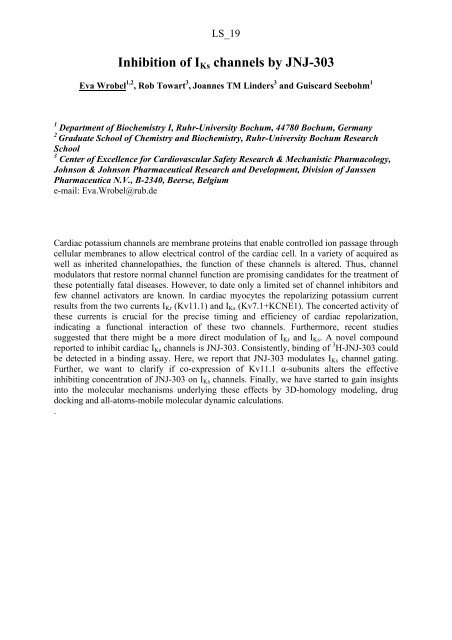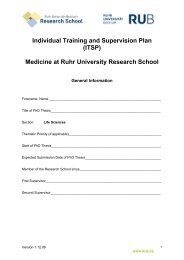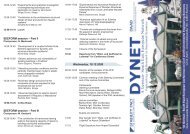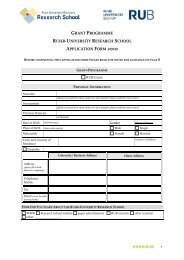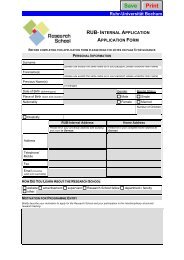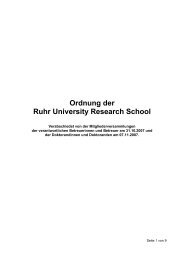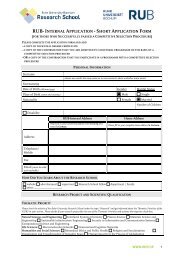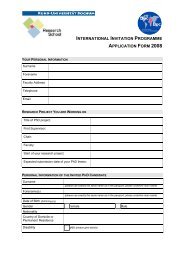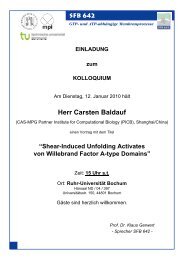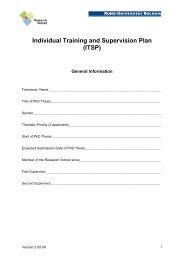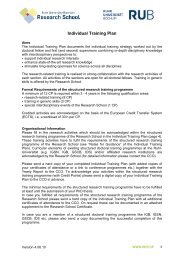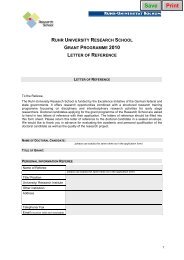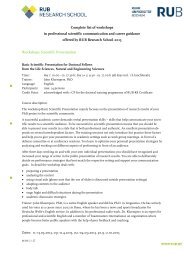Section Days abstract book 2010.indd - RUB Research School ...
Section Days abstract book 2010.indd - RUB Research School ...
Section Days abstract book 2010.indd - RUB Research School ...
You also want an ePaper? Increase the reach of your titles
YUMPU automatically turns print PDFs into web optimized ePapers that Google loves.
LS_19<br />
Inhibition of IKs channels by JNJ-303<br />
Eva Wrobel 1,2 , Rob Towart 3 , Joannes TM Linders 3 and Guiscard Seebohm 1<br />
1<br />
Department of Biochemistry I, Ruhr-University Bochum, 44780 Bochum, Germany<br />
2<br />
Graduate <strong>School</strong> of Chemistry and Biochemistry, Ruhr-University Bochum <strong>Research</strong><br />
<strong>School</strong><br />
3<br />
Center of Excellence for Cardiovascular Safety <strong>Research</strong> & Mechanistic Pharmacology,<br />
Johnson & Johnson Pharmaceutical <strong>Research</strong> and Development, Division of Janssen<br />
Pharmaceutica N.V., B-2340, Beerse, Belgium<br />
e-mail: Eva.Wrobel@rub.de<br />
Cardiac potassium channels are membrane proteins that enable controlled ion passage through<br />
cellular membranes to allow electrical control of the cardiac cell. In a variety of acquired as<br />
well as inherited channelopathies, the function of these channels is altered. Thus, channel<br />
modulators that restore normal channel function are promising candidates for the treatment of<br />
these potentially fatal diseases. However, to date only a limited set of channel inhibitors and<br />
few channel activators are known. In cardiac myocytes the repolarizing potassium current<br />
results from the two currents IKr (Kv11.1) and IKs (Kv7.1+KCNE1). The concerted activity of<br />
these currents is crucial for the precise timing and efficiency of cardiac repolarization,<br />
indicating a functional interaction of these two channels. Furthermore, recent studies<br />
suggested that there might be a more direct modulation of IKr and IKs. A novel compound<br />
reported to inhibit cardiac IKs channels is JNJ-303. Consistently, binding of 3 H-JNJ-303 could<br />
be detected in a binding assay. Here, we report that JNJ-303 modulates IKs channel gating.<br />
Further, we want to clarify if co-expression of Kv11.1 α-subunits alters the effective<br />
inhibiting concentration of JNJ-303 on IKs channels. Finally, we have started to gain insights<br />
into the molecular mechanisms underlying these effects by 3D-homology modeling, drug<br />
docking and all-atoms-mobile molecular dynamic calculations.<br />
.


